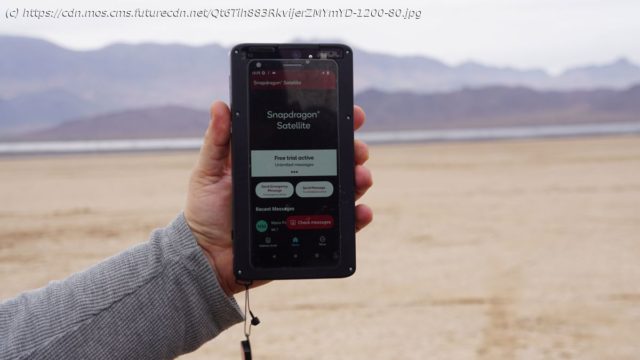We took a long ride into the desert at CES 2023 to see a live demo of Qualcomm’s new Snapdragon Satellite communications platform.
You’ve been misled. The new frontier of mobile connectivity isn’t 5G or even 6G, it’s satellite. Last year it was Apple unveiling its lineup of SOS via satellite-capable iPhone 14 handsets. This year it’s Qualcomm, laying the groundwork at CES 2023 for a legion of satellite-based two-way-messaging-capable Android phones in 2023 and beyond.
Demonstrating satellite communication capabilities, especially ones on mobile test platform handsets and with software that’s propriety and many steps from consumer availability, isn’t easy. Even when you’re only trying to do a simulated test, you want to take extraordinary measures to prove that your satellite systems work. And in lieu of that, you set the mood.
Qualcomm’s big idea for demonstrating Snapdragon Satellite to an eager group of tech journalists was to take us far, far away from the bustling, neon-light-filled, gambling mecca that is Las Vegas.
After piling into a party bus (complete with stripper poles), we drove almost 20 miles outside of the strip, past the gambling towers and aging old-school Vegas casinos like Golden Nugget. We drove until the landscape was barren and dotted with nothing but scrub. With the metal erector-set-like power lines standing like sentinels in the distance (and reminding me of that scene from Seven), we all piled out of the bus and onto the crusty desert soil. This would be Snapdragon Satellite’s proving ground.
There may still be vast swaths of earth that aren’t covered by cell signals, but as I glanced at my phone, I found, even though I couldn’t spot a cell tower, I still had strong 5G.
Though Qualcomm and, by extension, Android phones will be late to the consumer-grade Satellite communications party, Qualcomm is coming at it from a different direction. Sure, the system as described to me will, with the assistance of partner Garmin, provide emergency satellite communication and rescue services, but Snapdragon Satellite will start with something that, perhaps, more consumers want and will use: satellite-based two-way texting.
Based on Qualcomm’s Snapdragon 8 Gen 2 SoC and the Snapdragon X70 5G Modem-RF System will use new 1616hz and 1620hz bands to communicate with a vast network of low earth orbit (LEO) Iridium satellites.
Home
United States
USA — software Your next Android phone might text via satellite, thanks to Qualcomm






